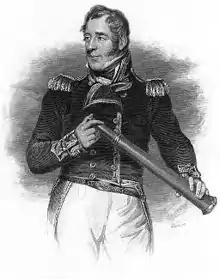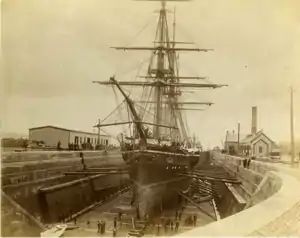Royal Navy Burying Ground (Halifax, Nova Scotia)
The Royal Navy Burying Ground is part of the Naval Museum of Halifax and was the Naval Hospital cemetery for the North America and West Indies Station at Halifax, Nova Scotia. It is the oldest military burial ground in Canada. The cemetery has grave markers to those who died while serving at Halifax and were treated at the Naval medical facility or died at sea. Often shipmates and officers had the grave markers erected to mark the deaths of the crew members who died while in the port of Halifax.
| Royal Navy Burying Ground | |
|---|---|
 Royal Navy Burying Ground, Halifax, Nova Scotia | |
| Details | |
| Established | 1781 |
| Location | |
| Country | Canada |
| Coordinates | 44.661331°N 63.591574°W |
| Type | Closed |
| Owned by | Naval Museum of Halifax |
| No. of graves | 400+ |
| Website | Official website |
| Find a Grave | Royal Navy Burying Ground |
The number of burials is estimated at over 400, however, there are only 89 stone markers remaining.[1] There was a register of deaths established in 1860 for the burial ground. As well, surgeons of a ship registered the deaths of crew members, including how the person died and where they were buried. These reports were entered in the official register, with a detailed account sent quarterly to the Medical Director-General, Admiralty, England.[fn 1] There is no local record of who is buried. The four most common causes of death in order are: disease, falling from the topmast, drowning, and death as a result of naval battles.
Along with two monuments that commemorate casualties of the War of 1812,[3] the most prominent markers are for the crew that died on the flagships of the North American and West Indies Station: HMS Winchester (1841), HMS Wellesley (1850), HMS Cumberland (1852), HMS Indus (1859), HMS Nile (1861), HMS Duncan (1866), and HMS Royal Alfred (1869). There were many buried during the wars of the 18th century (American Revolution, French Revolutionary War and Napoleonic Wars) that do not have grave markers.
Flagships of the North America and West Indies Station (1836–1869)
The following is a list of the flagships and their commanders who commemorated their lost crew members through erecting a monument in the Burying Ground. Some monuments reflect those killed in a single event and other monuments include all those who were killed while the flagship was stationed on the North America and West Indies Station at Halifax. After the names of the ship there is a date that is the year the last person listed on the monument died.
Crew of HMS Vernon (1836)
 HMS Vernon (1833)
HMS Vernon (1833).png.webp) Cockburn's flagship HMS Vernon
Cockburn's flagship HMS Vernon%252C_by_John_James_Halls.jpg.webp) Sir George Cockburn, 10th Baronet,; served at Halifax (1832–1836)
Sir George Cockburn, 10th Baronet,; served at Halifax (1832–1836)
Crew of HMS Melville (1837)
.png.webp)
 HMS Melville (1837)
HMS Melville (1837)
Crew of HMS Vindictive (1845)
 HMS Vindictive – four died (1846)[fn 2]
HMS Vindictive – four died (1846)[fn 2] HMS Vindictive
HMS Vindictive
 Captain Charles Austen, commanded flagship HMS Winchester in Halifax (1828–1830) (Jane Austen's brother)[5]
Captain Charles Austen, commanded flagship HMS Winchester in Halifax (1828–1830) (Jane Austen's brother)[5]
Crew of HMS Wellesley (1850)
There is a monument to eleven crew that died over a two-year period on HMS Wellesley at Halifax (1848–1850). The ship was commanded by Captain George Goldsmith and was the flagship of Vice-Admiral Thomas Cochrane, 10th Earl of Dundonald, North America and West Indies Station.[6]
 HMS Wellesley – eleven died (1850)
HMS Wellesley – eleven died (1850) Thomas Cochrane
Thomas Cochrane HMS Wellesley
HMS Wellesley "Captain George Goldsmith RN, H.M. Ship Wellesley, Halifax", July 1850
"Captain George Goldsmith RN, H.M. Ship Wellesley, Halifax", July 1850
Crew of HMS Cumberland (1852)
There is also a monument to six crew who died on the flagship HMS Cumberland from 1851 to 1852. The commander was Captain George Henry Seymour, and his father was the Vice Admiral Sir George Francis Seymour. [7]
 HMS Cumberland – six died (1852)
HMS Cumberland – six died (1852) Sir George Francis Seymour
Sir George Francis Seymour HMS Cumberland, c. 1852
HMS Cumberland, c. 1852
Crew of HMS Indus (1859)
The crew and officers of HMS Indus created a gravestone for one of their fellow crew members who died in 1859. The vessel was the flagship of Sir Houston Stewart, Vice-Admiral of the Blue. The commander was Captain William King-Hall.
 Sir Houston Stewart
Sir Houston Stewart One died – HMS Indus and Squadron leaving Halifax Harbour, 1858
One died – HMS Indus and Squadron leaving Halifax Harbour, 1858 Captain William King-Hall and crew, HMS Indus, Halifax, Nova Scotia, 1860
Captain William King-Hall and crew, HMS Indus, Halifax, Nova Scotia, 1860
Crew of HMS Nile (1861)
Admiral of the Fleet Sir Alexander Milne (Commander-in-Chief, North American Station at Halifax, 1860–64) erected a monument to his son and 14 other crew members who died over a period of 18 months on his flagship HMS Nile (1861).[fn 3] The Admiral's son was one of six who died in one week. Two more died within the month. (Note: There is another stone that commemorates a single crew member. No date.)
 HMS Nile Monument – 16 died (1861)
HMS Nile Monument – 16 died (1861)%252C_by_Walter_William_Ouless.jpg.webp) Admiral Milne – buried his son
Admiral Milne – buried his son HMS Nile[9]
HMS Nile[9]
Crew of HMS Duncan (1866)
The shipmates/messmates of HMS Duncan erected four stones for five crew (8 September 1864, 1865, 1865, 1866). 6 January 1864: Commanded by Captain Robert Gibson, flagship of Vice-Admiral James Hope, North America and West Indies.[10][11] Whilst serving on the North America and West Indies Station, Captain John Bythesea VC was carried on the books of Duncan as second captain from 1 April 1866 to Spring 1867, for special service as Naval Attaché in Washington.[12]
 HMS Duncan – five died (1866)
HMS Duncan – five died (1866) Sir James Hope
Sir James Hope HMS Duncan, Halifax, Nova Scotia, c. 1865
HMS Duncan, Halifax, Nova Scotia, c. 1865
Crew of HMS Royal Alfred (1869)
In 1869, a monument to the four crew that died aboard flagship HMS Royal Alfred was created by Admiral of the Fleet Rodney Mundy (Commander-in-Chief, North American Station).[fn 4] The crew of HMS Royal Alfred have the most markers in the burying ground. There are seven gravestones for ten people. The last grave marker was for the infant daughter of the surgeon on board ship.[13] The Royal Alfred was the flagship of Vice-Admiral Sir George Rodney Mundy, 1867–1869.[14]
 HMS Royal Albert – ten died (1869)
HMS Royal Albert – ten died (1869) Sir Rodney Mundy
Sir Rodney Mundy HMS Royal Alfred, Halifax Harbour, Nova Scotia, ca. 1870
HMS Royal Alfred, Halifax Harbour, Nova Scotia, ca. 1870
Officers
There are only two stones that mark the graves of officers. The identity of the admiral has never been confirmed.
- Admiral Domes (Barnes? Tomes?) drowned while posted on the flagship HMS Renown (–1898).[fn 5]
- Captain George Oliver Evans, (–1868) Capt., Royal Marines Light Infantry, 6 June 1868, 36 years. Captain Evans fought in both the Crimean War (Balaclava, Sevastopol, Kinburn), as well as the Second Opium War (Canton).[16][17] He served as the aide-de-camp to Sir Thomas Holloway (1858–60).[18]
 HMS Renown, Halifax, Nova Scotia (1898)
HMS Renown, Halifax, Nova Scotia (1898) Captain George Oliver Evans (1868)
Captain George Oliver Evans (1868)
Other
Individual crew members
Listed below are the ships that were not flagships and whose crews commemorated the loss of a single sailor with a gravestone:
- HMS Vernon (1808); HMS Mersey (1820); HMS Alligator (1827); HMS Columbus (1837); HBM Sloop Pilot (1841); HMS Sydenham (1843); HMS Scourge (1848); HMS Edgar (1862); HMS Medea (1865); HMS Doris (1868); HMS Constance (1868); HMS Valorous; HMS Racoon (1874).
 HMS Galatea, 1865 (left of center)[fn 6]
HMS Galatea, 1865 (left of center)[fn 6] HMS Galatea, Halifax, Nova Scotia, c.1868.
HMS Galatea, Halifax, Nova Scotia, c.1868. HMS Crescent, Halifax, Nova Scotia (1885)
HMS Crescent, Halifax, Nova Scotia (1885).png.webp) HMS Tourmaline (1888)
HMS Tourmaline (1888).jpg.webp) HMS Winchester (1841)[20]
HMS Winchester (1841)[20]
Multiple crew members
The following four ships were not flagships and had multiple deaths while at the Halifax station, which the crews commemorated by a single monument.
- Six died – HMS Orion, 1857 – Halifax, July 27–August 5, 1857, Captain John Elphinstone Erskine

 HMS Canada – three died (1887)
HMS Canada – three died (1887)
Women and children

There are also grave stones for women (9) and children (18). Many of the children were infants. The most prominent of these grave markers was erected by Charles Stubbing who was the Admiralty Clerk between 1867 and 1893.[26] [27] He created a grave stone that lists his first and second wife and five of his children. He lost two of his children and his second wife in the same year (1882). He created another gravestone for the loss of his third wife.
War of 1812
During the War of 1812, 220 British naval sailors died in the Naval Hospital at Halifax.[28] The most famous of these were those that died as a result of the battle between USS Chesapeake and HMS Shannon. The marker for the Shannon was created in 1868, while the marker for the Chesapeake was created in 1966.
Crew of HMS Shannon (1813)
Admiral of the Fleet Rodney Mundy (Commander-in-Chief, North American Station) refurbished the original monument that was created for the seven who died in the Naval Hospital who served on HMS Shannon (1868).[29]
Shannon's midshipmen during the action were Messrs. Smith, Leake, Clavering, Raymond, Littlejohn and Samwell. Samwell was the only other officer to be wounded in the action. Mr Etough was the acting master, and conned the ship into the action. Shortly after the frigate had been secured, Broke fainted from loss of blood and was rowed back to Shannon to be attended to by the ship's surgeon. After the victory, a prize crew was put aboard Chesapeake and Shannon escorted her and her crew into Halifax, arriving there on 6 June. Lieutenant Bartholomew Kent, of Nova Scotia brought the first news of the British victory back to London.
At Halifax Chesapeake's crew was imprisoned. Chesapeake herself was repaired and taken into service by the Royal Navy before she was sold at Portsmouth, England in 1820 and broken up.
 HMS Shannon – 7 died (1813)
HMS Shannon – 7 died (1813).jpg.webp) HMS Shannon leading USS Chesapeake into Halifax Harbour in June 1813, by John C. Schetky
HMS Shannon leading USS Chesapeake into Halifax Harbour in June 1813, by John C. Schetky
Crew of USS Chesapeake (1813)
There was a monument erected to the twelve crewmen of USS Chesapeake who died in the Halifax Naval Hospital (1966).
Captain Philip Broke boarded Chesapeake at the head of a party of 20 men. They met little resistance from Chesapeake's crew, most of whom had run below deck. The only resistance from Chesapeake came from her contingent of marines. The British soon overwhelmed them; only nine escaped injury out of 44.[30] Broke was severely injured in the fighting on the forecastle, being struck in the head with a sword. Soon after, Shannon's crew pulled down Chesapeake's flag. Only 15 minutes had elapsed from the first exchange of gunfire to the capture.[31][32]
Reports on the number of killed and wounded aboard Chesapeake during the battle vary widely. Broke's after-action report from 6 July states 70 killed and 100 wounded.[33] Contemporary sources place the number between 48 and 61 killed and 85–99 wounded.[34][35] Discrepancies in the number of killed and wounded are possibly caused by the addition of sailors who died of their wounds in the ensuing days after the battle.[36] The counts for Shannon have fewer discrepancies with 23 killed; 56 wounded.[37] Despite his serious injuries, Broke ordered repairs to both ships and they proceeded on to Halifax, Nova Scotia. Captain James Lawrence died en route and was buried in Halifax with military honors. The British imprisoned his crew. Broke survived his wounds and was later made a baronet.[38][39]
 USS Chesapeake – 12 died (1813)
USS Chesapeake – 12 died (1813).jpg.webp) HMS Shannon capturing USS Chesapeake off Boston, 1 June 1813, by W. Elmes
HMS Shannon capturing USS Chesapeake off Boston, 1 June 1813, by W. Elmes Memorials to USS Chesapeake and HMS Shannon
Memorials to USS Chesapeake and HMS Shannon
See also
Footnotes
- There is a list of burials from 1860 until 1905, which was held at the Public Record Office, Chancery Lane,[2] and is now at the British National Archives.
- Two stones; four crew (1845, 1846)
- Commander of HMS Nile Captain Edward King Barnard (b. 1815, later Rear-Admiral[8]) also was involved in erecting the monument.
- Note: Grave marker for Henry Smith Coolen (marker No. 15) indicates the date Nov. 18, 1862, which does not coincide with the dates HMS Royal Alfred was sailing.
- Died while on board Renown, August 4, 1898. HMS Renown, Flagship of the North America and West Indies Station, under the command of Admiral Sir John A. Fisher, Captain Daniel M. Riddel while in Halifax, 1897–1899.[15] Given the lack of formality of the gravestone, one might conclude that "Admiral Tomes" was a nickname for a crew member rather than an actual admiral.
- In memory of Alexander F. Carroll Royal Navy who died on board H.M.S. Galatea at Halifax, Nova Scotia June 17th 1865 aged 18 years.[19]
- HMS Sphinx stone erected by Capt. Thomas Barnardiston; buried at sea because of yellow fever (1874). Note the dates of the grave markers do not coincide with the dates HMS Sphinx was sailing.
References
- Citations
- "Unmarked graves sought in navy cemetery". CBC. 18 July 2011. Retrieved 21 October 2014.
- Stubbing (1908), pp. 107–108.
- Stubbing (1908), p. 108.
- Jane Austen Society
- The diary and private journal of Charles John Austen (latterly Rear Admiral) for 1830 is held by the National Maritime Museum: The Caird Library, Manuscripts Section Record Reference AUS/131-132. NRA catalogue reference. NRA 30121.
- p.21
- "H.M.S. Cumberland". Royal Museums Greenwich.
- O'Byrne, William Richard (1849). A Naval Biographical Dictionary: comprising the life and services of every living officer in Her Majesty's navy, from the rank of admiral of the fleet to that of lieutenant, inclusive. London: John Murray. p. 48.
- Windsor, Alfie (1998). "The Third HMS Conway: HMS Nile 1826–1876". HMS Conway 1859–1974.
- Lambert, Andrew (1984). Battleships in Transition: The Creation of the Steam Battlefleet, 1815–1860. London: Conway Maritime Press. p. 124. ISBN 978-0851773155.
Lambert says that she became flagship in 1865 and paid off in 1868
- "HMS Duncan". William Loney RN.
- "John Bythesea". William Loney RN.
- Mitchell, W. F.; Elgar, Francis (1872). The Royal Navy; in a series of illustrations from original drawings. Portsmouth: Griffin. p. 30.
- "HMS Royal Alfred, Halifax Harbour, NS". The Nova Scotia Archives. 20 April 2020.
- "Daniel McNab Riddel". The Dreadnought Project.
- Hart, Colonel H. G. (1865). The New Army List, and Militia List. p. 346.
- Hart, Colonel H. G. (1865). The New Army List, and Militia List. p. 446.
- Hart, Henry George (1875). The New Annual Army List, Militia List, and Indian Civil Service List. p. 400.
- "Carroll". North of Ireland Family History Society.
- Note the Winchester had previously been the flagship for Admiral Edward Colpoys when he was at Halifax (1816–1821)
- The Nautical Magazine: A Journal of Papers on Subjects Connected with Maritime Affairs. Brown, Son and Ferguson. 1873. p. 958.
- Admiralty, Great Britain (20 December 1873). The Navy List. p. 175.
- Admiralty, Great Britain (1877). The Navy List. p. 235.
Capt Barnardiston was formerly commander of HMS Rover.
- "Image of HMS Canada entering dry dock, Halifax Ship Yard". Nova Scotia Archives. 20 April 2020.
- HMS Canada, July 10, 1887
- Stubbing (1908), p. 103.
- "Nova Scotia Archives – the Royal Engineers in Halifax". 20 April 2020.
- Trask, Deborah (2015). "Putting the War of 1812 to Rest". Royal Nova Scotia Historical Society Journal. 18: 61.
- "List of killed aboard HMS Shannon". The Naval Chronicle. London: J. Gold. XXX: 84. 1813.
- Roosevelt (1882), p. 185.
- Roosevelt (1882), pp. 186–187.
- Cooper (1856), p. 307.
- "No. 16750". The London Gazette. 6 July 1813. p. 1330.
- Maclay & Smith (1910), p. 459.
- Beach (1986), p. 110.
- Toll (2006), p. 415.
- "No. 16750". The London Gazette. 6 July 1813. p. 1329.
- Roosevelt (1882), p. 187.
- Cooper (1856), p. 308.
- Bibliography
- Royal Navy Burying Ground: List of known interred, Maritime Naval Museum pamphlet.
- "William Batchell. Old Royal Navy Burial Ground Halifax. 6 Feb. 2016". Nova Scotia History. 6 February 2016.
- Beach, Edward L. (1986). The United States Navy: 200 Years. New York: H. Holt. ISBN 978-0030447112.
- Cooper, James Fenimore (1856) [1839]. History of the Navy of the United States of America. New York: Stringer & Townsend.
- Maclay, Edgar Stanton; Smith, Roy Campbell (1910) [1893]. A History of the United States Navy, from 1775 to 1901. Vol. 1 (New and Enlarged ed.). New York: D. Appleton & Co.
- Roosevelt, Theodore (1882). The Naval War of 1812. New York: G.P. Putnam's Sons.
- Stubbing, Charles H. (1908). "Dockyard Memoranda, 1894". Collections of the Nova Scotia Historical Society. Halifax, Nova Scotia: McAlpine Publishing Co. XIII.
- Toll, Ian W. (2006). Six Frigates: The Epic History of the Founding of the US Navy. New York: W. W. Norton. ISBN 0393058476.